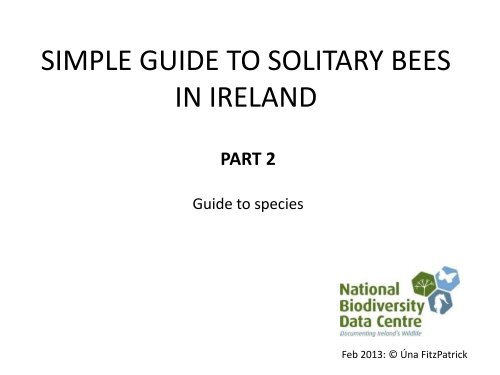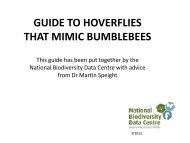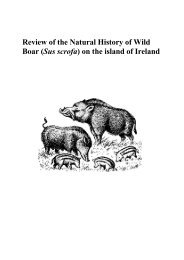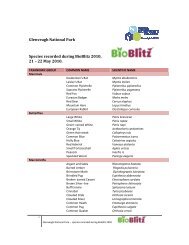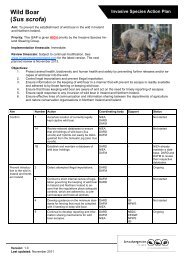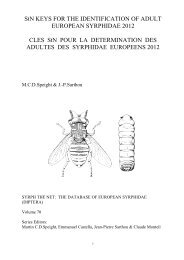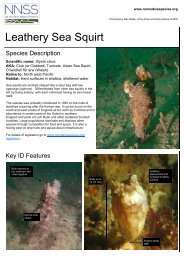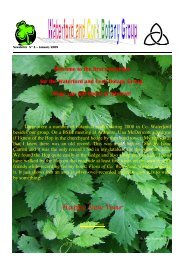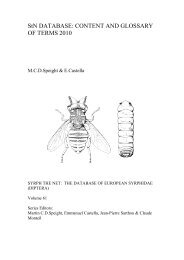Simple guide to solitary bees in Ireland_ part 2 - Pollinators
Simple guide to solitary bees in Ireland_ part 2 - Pollinators
Simple guide to solitary bees in Ireland_ part 2 - Pollinators
You also want an ePaper? Increase the reach of your titles
YUMPU automatically turns print PDFs into web optimized ePapers that Google loves.
SIMPLE GUIDE TO SOLITARY BEESIN IRELANDPART 2Guide <strong>to</strong> speciesFeb 2013: © Úna FitzPatrick
GUIDE TO SPECIESThese are NOT keys. They are simply <strong>in</strong>tended as a<strong>guide</strong> <strong>to</strong> help make the group more accessible <strong>to</strong>beg<strong>in</strong>ners. They refer only <strong>to</strong> species currentlyknown from <strong>Ireland</strong>
Special thanks <strong>to</strong> Josef Dvořák who has very k<strong>in</strong>dlyallowed his pho<strong>to</strong>graphs of p<strong>in</strong>ned specimens <strong>to</strong> beused <strong>in</strong> this <strong>guide</strong>.http://www.biolib.cz/en/gallery/dir388
The follow<strong>in</strong>g websites provide excellent <strong>in</strong>formation andpho<strong>to</strong>graphs of <strong>solitary</strong> <strong>bees</strong>Fantastic site with maps,pho<strong>to</strong>graphs and profiles ofBees from Brita<strong>in</strong> & <strong>Ireland</strong>http://www.bwars.com
http://www.biolib.cz/en/gallery/dir388/BioLib is an <strong>in</strong>ternationalencyclopaedia of plants,fungi and animals. It hasexcellent pho<strong>to</strong>graphs of<strong>solitary</strong> <strong>bees</strong>.
http://poll<strong>in</strong>a<strong>to</strong>rs.biodiversityireland.ie/There are species accountsfor all Irish <strong>bees</strong> on the IrishPoll<strong>in</strong>a<strong>to</strong>r Initiative website.
BEES WITH TWO CELLS IN THEIR WINGS•Coelioxys•Osmia•Megachile•Hylaeus
2 cells <strong>in</strong> w<strong>in</strong>gVery simple key <strong>to</strong> thegenera known from <strong>Ireland</strong>Bee hairyBee small, black & almost hairlessHylaeusEyes hairyCoelioxysEyes not hairyFeet with prom<strong>in</strong>entpad between clawsOsmiaFeet without a padbetween clawsMegachile
Coelioxys (Sharp tailed <strong>bees</strong>)Hairy eyes2 Irish species (C. <strong>in</strong>ermis & C. elongata)Eyes hairyMedium sized bee (9-15mm)Tapered abdomen, <strong>part</strong>icularly femalesRare but found <strong>in</strong> a range of habitatsCuckoo <strong>bees</strong> – they parasitise MegachilenestsSharply tapered abdomen,<strong>part</strong>icularly females
FEMALES: When viewed under amicroscope, the abdom<strong>in</strong>al segments havemuch denser punctuation (dots or pits onsurface) <strong>in</strong> C. elongata than <strong>in</strong> C. <strong>in</strong>ermis .It is useful <strong>to</strong> get records ofCoelioxys at the genus level –the tapered abdomen isdist<strong>in</strong>ctive
Osmia (Mason <strong>bees</strong>)2 Irish speciesChunky bee with large rounded abdomenO. aurulenta is coastal and nests only <strong>in</strong> empty snail shells. It is only found along the east andsoutheast coast.O.rufa is rare & known only from cities: Dubl<strong>in</strong>, Belfast & Cork where it has probably beendeliberately <strong>in</strong>troduced (commercially available <strong>in</strong> UK as a garden poll<strong>in</strong>a<strong>to</strong>r).It can be possible <strong>to</strong> spot Osmia aurulenta <strong>in</strong>action <strong>in</strong> coastal sites along the east coast –check snail shellsmedium sized <strong>solitary</strong> species (7-12mm)females have g<strong>in</strong>ger hairs on the thorax,and g<strong>in</strong>ger hair bands on the abdomenwhich are most obvious at the tip© Michael O’Donnell
©Josef Dvořák: http://www.biolib.cz/en/gallery/dir388
Megachile (Leaf cutter <strong>bees</strong>)6 Irish speciesUnderside of abdomenhairy – <strong>to</strong> s<strong>to</strong>re pollenMegachile centuncularisMegachile circumc<strong>in</strong>ctaMegachile lignisecaMegachile maritimaMegachile versicolorMegachile willughbiellaLarge, chunky beeS<strong>to</strong>res pollen on the underside of itsabdomenLeaf cutter <strong>bees</strong> cut out leaves/petals anduse these <strong>to</strong> build nestsFound <strong>in</strong> a range of habitatsGood key is available: Identification ofLeaf-cutter <strong>bees</strong> British Wildlife August1999; 390-393.When p<strong>in</strong>n<strong>in</strong>g it is important <strong>to</strong> p<strong>in</strong> outthe jaws as the teeth are used <strong>in</strong>identificationM. willughbiella
©Josef Dvořák: http://www.biolib.cz/en/gallery/dir388To positively ID Megachile <strong>to</strong>species you have <strong>to</strong> take a lethalsample and use microscopefacilities
Hylaeus (White faced <strong>bees</strong>)4 Irish speciesHylaeus brevicornisHylaeus communisHylaeus confususHylaeus hyal<strong>in</strong>atusSmall, black body, almosthairlessSmall, black <strong>bees</strong> (5-7mm)Face with yellow or white mark<strong>in</strong>gsAlmost hairlessFound <strong>in</strong> a range of habitatsFace with yellow or whitemark<strong>in</strong>gs
Hylaeus males – have a look at the faceIf the face has yellowcurl<strong>in</strong>g around theantennal sockets it isHylaeus communisIf the mandibles are<strong>part</strong>ly yellow-white itis Hylaeus confususIf the mandibles areblack it is eitherHylaeus hyal<strong>in</strong>atus orHylaeus brevicornis©Josef Dvořák: http://www.biolib.cz/en/gallery/dir388
Hylaeus females – have a look at the antennaeIf the antennae is entirely blackit is either Hylaeus communisor Hylaeus confususIf the antennae is not entirelyblack (pale on the underside) itis either Hylaeus hyal<strong>in</strong>atus orHylaeus brevicornis
A good key is availableon the BWARS website
BEES WITH THREE CELLS IN THEIR WINGS•Xylocopa•Sphecodes•Colletes•Halictus•Lasioglossum•Nomada•Andrena
Very simple key <strong>to</strong> thegenera known from <strong>Ireland</strong>3 cells <strong>in</strong> w<strong>in</strong>gTwo genera are very dist<strong>in</strong>ctiveXylocopaSphecodesVery large entirely black beewith dark w<strong>in</strong>gsAlmost hairless, black & red abdomen
3 cells <strong>in</strong> w<strong>in</strong>gNot Xylocopa or SphecodesVery simple key <strong>to</strong> thegenera known from <strong>Ireland</strong>This l<strong>in</strong>earchedThis l<strong>in</strong>e smoothor with gentlecurveVery obvious hairbands on abdomenHair bands absen<strong>to</strong>r not obviousLasioglossumHairyAndrenaAlmost hairlessNomadaCell on leftsimilar <strong>to</strong> oneon rightCell on leftlarger than oneon rightWasp like – abdomenwith yellow, black orred bandsColletesHalictus
Xylocopa (Carpenter <strong>bees</strong>)1 species: Xylocopa violaceaeVery large black beeNot unlike a giant black blue bottle!Nests <strong>in</strong> dead woodOnly 1 record – Waterford City <strong>in</strong>2007Could be identified<strong>in</strong> the field
Sphecodes (Cuckoo sweat <strong>bees</strong>)7 Irish speciesSphecodes ephippiusSphecodes ferrug<strong>in</strong>atusSphecodes geoffrellusSphecodes gibbusSphecodes hyal<strong>in</strong>atusSphecodes monilicornisSphecodes pellucidusSmall <strong>to</strong> medium sized <strong>bees</strong> (6-12mm)Black with red on the abdomenParasite of Halictus/Lasioglossum andfound <strong>in</strong> a variety of habitatsDifficult <strong>to</strong> identify <strong>to</strong> species level When p<strong>in</strong>n<strong>in</strong>g it is important <strong>to</strong> p<strong>in</strong>out genetalia & jawsS. eppiphiusRed on the abdomen isdist<strong>in</strong>ctive of the genus
©Josef Dvořák: http://www.biolib.cz/en/gallery/dir388Requires lethal sampl<strong>in</strong>g.Difficult <strong>to</strong> identify <strong>to</strong> species
ColletesDist<strong>in</strong>ctive white hair bandson the abdomen4 Irish speciesColletes daviesanusColletes floralisColletes similisColletes succ<strong>in</strong>ctusMedium sized bee (8-13mm)Dist<strong>in</strong>ctive bands of white hair on theabdomenC. floralis, C. similis and C. daviesanus (v.rare) are all coastal<strong>Ireland</strong> holds a significant proportion of theworld population of C. floralisC. succ<strong>in</strong>ctus occurs only on bog/heath andis a late summer species
Colletes succ<strong>in</strong>ctusmedium sized <strong>solitary</strong> species, butlargest Colletes species <strong>in</strong> <strong>Ireland</strong> (10-13mm)thorax with reddish hair (fades with age)both males and females with prom<strong>in</strong>entbands of white hair on the abdomenRecorded from June-SeptemberOccurs on bogs/heaths where it feeds onheathersNests <strong>in</strong> large aggregations©Josef Dvořák: http://www.biolib.cz/en/gallery/dir388With care females can be identified<strong>in</strong> the field. Look <strong>in</strong> the right habitatfor a <strong>solitary</strong> species with white hairbands on the abdomen
Colletes – coastal speciesC. similis C. floralis C. daviesanusCurrently found only oneast and south east coastRare and only found on sandycliffs <strong>in</strong> <strong>Ireland</strong>
Colletes – coastal femalesThe three species look superficiallysimilar.If the punctures (dots or pits on surface)of the first abdom<strong>in</strong>al segment areseparated by a puncture width or more itis C. floralis or C. daviesanusIf the punctures (dots or pits on surface)on the first abdom<strong>in</strong>al segment areseparated by considerably less than apuncture width it is C. similisThis is obviously difficult <strong>to</strong> determ<strong>in</strong>ethis without reference specimens – as aremany other features used <strong>in</strong> <strong>solitary</strong> beeidentification©Josef Dvořák: http://www.biolib.cz/en/gallery/dir388Coastal females can onlybe positively identified bylethal sampl<strong>in</strong>g
Halictus (Sweat <strong>bees</strong>)With care femalescan be identified <strong>in</strong>the field2 Irish speciesHalictus rubicundusmedium sized <strong>solitary</strong> species(9-12mm)females have g<strong>in</strong>ger hairs onthorax, obvious white hairbands on the abdomen andorange h<strong>in</strong>d legsmales are smaller and havehairier faces and a moreelongate abdomenvery commonCell on the rightlarger than theadjacent cell on theleft (=Halictus)Obvious hairbands onabdomenOrange legs©Josef Dvořák: http://www.biolib.cz/en/gallery/dir388
Halictus tumulorumsmall sized <strong>solitary</strong> species (6-8mm)rarely recordedfemales have a sh<strong>in</strong>y abdomen with th<strong>in</strong> white hairbands and dull orange/brown h<strong>in</strong>d legsmales are smaller and have a more elongate abdomencan be confused with the smaller Lasioglossum species.©Josef Dvořák: http://www.biolib.cz/en/gallery/dir388Can only be positivelyidentified by lethalsampl<strong>in</strong>g
Lasioglossum11 Irish speciesMa<strong>in</strong>ly small <strong>bees</strong>, often blackThree of the 11 species look metallicFound <strong>in</strong> a variety of habitatsCan be difficult <strong>to</strong> identify <strong>to</strong> species
Metallic (3)L. leucopus (5-6mm)L. smeathmanellum (5-7mm)L. cupromicans (6-7mm)The metallic colour<strong>in</strong>g is not always this obviousNon metallic (8)L. albipes (7-10mm)L. calceatum (7-10mm)L. fratellum (7-9mm)L. lativentre (7-9mm)L. nitidiusculum (6-7mm)L. punctatissimum (6-7mm)L. rufitarse (7-8mm)L. villosulum (6-7mm)©Josef Dvořák: http://www.biolib.cz/en/gallery/dir388
©Josef Dvořák: http://www.biolib.cz/en/gallery/dir388Requires lethal sampl<strong>in</strong>g. Can bedifficult <strong>to</strong> identify <strong>to</strong> species
Nomada (Cuckoo <strong>bees</strong>)12 Irish speciesNomada argentataNomada fabricianaNomada flavoguttataNomada goodenianaNomada leucophthalmaNomada marshamellaNomada obtusifronsNomada panzeriNomada ruficornisNomada rufipesNomada sheppardanaNomada striataCan resemble wasps – oftenhave black, yellow or redstripes on abdomenCuckoo <strong>bees</strong> – they parasitiseAndrena nests
Three Nomada species have females that can be identified <strong>in</strong> the field. Thesespecies have an abdomen that is black and yellow only (no red mark<strong>in</strong>gs)N. marshamella (9-13mm)N. goodeniana (9-13mm) N. rufipes (8-10mm)Orange/brown legs and antennae. Second yellow bandon abdomen is entire <strong>in</strong> N. goodeniana (not broken <strong>in</strong> thecentre) whereas <strong>in</strong> N. marshamella it is brokenYellow bands on abdomenwidely broken <strong>in</strong> N. rufipes©Josef Dvořák: http://www.biolib.cz/en/gallery/dir388
The female of N. fabriciana (7-11mm) also has two dist<strong>in</strong>ctive features1. Not visible here but females have a dist<strong>in</strong>ctive two<strong>to</strong>ne antennae- the tip and lower half are red/brownseparated by black segments <strong>in</strong> between.2. Bidentate (two teeth)©Josef Dvořák: http://www.biolib.cz/en/gallery/dir388Can only be positivelyidentified by lethalsampl<strong>in</strong>g
There is one very small Nomada speciesN. sheppardanaVery small (4-6mm)Very rareExt<strong>in</strong>ct <strong>in</strong> <strong>Ireland</strong> (last recorded 1902)©Josef Dvořák: http://www.biolib.cz/en/gallery/dir388Can only be positivelyidentified by lethalsampl<strong>in</strong>g
Andrena (M<strong>in</strong><strong>in</strong>g <strong>bees</strong>)29 Irish speciesVery variable <strong>in</strong> form and occur from large species<strong>to</strong> very smallFound <strong>in</strong> a variety of habitatsThe <strong>solitary</strong> bee most often spotted by most peopleAndrena angustiorAndrena apicataAndrena barbilabrisAndrena bicolorAndrena c<strong>in</strong>erariaAndrena clarkellaAndrena coitanaAndrena denticulataAndrena fucataAndrena fulvaAndrena fuscipesAndrena haemorrhoaAndrena helvolaAndrena humilisAndrena lapponicaAndrena marg<strong>in</strong>ataAndrena m<strong>in</strong>utulaAndrena nigroaeneaAndrena ovatulaAndrena pilipesAndrena praecoxAndrena rosaeAndrena semilaevisAndrena scoticaAndrena stragulataAndrena subopacaAndrena tarsataAndrena trimmeranaAndrena wilkella
Three Andrena species have females that can be identified <strong>in</strong> the fieldAndrena c<strong>in</strong>eraria•The females are black, and have twodist<strong>in</strong>ctive grey hair bands across thethorax (there are no other <strong>solitary</strong> <strong>bees</strong>like this known from <strong>Ireland</strong>)•Large sized species (13-16mm)•It is a spr<strong>in</strong>g species and is generallyobserved between March – June. Theearliest it has been recorded <strong>in</strong> <strong>Ireland</strong> is22 nd March (2011).•Widespread. It is found <strong>in</strong> a range ofhabitats, but <strong>in</strong> <strong>Ireland</strong> it often relies onWillow as an early forage source•It nests <strong>in</strong> the ground. The nestentrances will be surrounded by avolcano-like mound of excavated spoil.Nests are often <strong>in</strong> dense aggregations
Three Andrena species have females that can be identified <strong>in</strong> the fieldAndrena haemorrhoa•The females are black, with ag<strong>in</strong>ger thorax, orange h<strong>in</strong>d legs,and dist<strong>in</strong>ctive red hairs at the tipof the abdomen (there are otherAndrena species that look similarbut none with a red tippedabdomen).•Medium sized <strong>solitary</strong> species(11-13mm)•It emerges <strong>in</strong> spr<strong>in</strong>g, and can beseen from March – August•Common and widespread. It isfound <strong>in</strong> a range of habitat types,<strong>in</strong>clud<strong>in</strong>g parks and gardens
Three Andrena species have females that can be identified <strong>in</strong> the fieldAndrena fulva•A. fulva was last recorded <strong>in</strong> Kilkenny <strong>in</strong>1925, and was assumed ext<strong>in</strong>ct <strong>in</strong> <strong>Ireland</strong>until 2012.•In 2012 it was recorded <strong>in</strong> two locations: Co.Kilkenny (close <strong>to</strong> it’s 1925 location) and Co.Wicklow.•Females are very dist<strong>in</strong>ctive with bright redhairs on the thorax and abdomen.•Medium-large sized <strong>solitary</strong> species (12-14mm).•It is a spr<strong>in</strong>g species (March – June).•It nests <strong>in</strong> the ground. The nest entranceswill be surrounded by a volcano-like moundof excavated spoil.
Three Andrena species have females that have an orange h<strong>in</strong>d leg©Josef Dvořák: http://www.biolib.cz/en/gallery/dir388A. haemorrhoaOrange h<strong>in</strong>d leg (both leg and hairs are orange)Andrena tarsataMedium sized (8-11mm)Mandible with 3 teethFeeds only on PotentillaSummer flight period (June- August)* Andrena haemorrhoa also has an orange h<strong>in</strong>d tibia (pho<strong>to</strong> above)
Andrena clarkella:Large (11-15mm)Tail hairs dark. Abdomen hairySpr<strong>in</strong>g flight period (March-June)Feeds only on willowAndrena wilkella:Large (10-12mm)Tail hairs golden. Abdomen baldMay - AugustFound <strong>in</strong> a range of habitats©Josef Dvořák: http://www.biolib.cz/en/gallery/dir388
Three Andrena species have females that have an abdomen with red mark<strong>in</strong>gs(all very rare)Andrena marg<strong>in</strong>ataTail redSummer flightGrassland species (Feeds on Scabiosa, Succisa, Knautia)Very rareAndrena rosaeTail blackSummer flight period (July-September)Very rare (last recorded 1896)Andrena stragulataTail blackSpr<strong>in</strong>g flight (March-April)Very rare (last recorded 1977)©Josef Dvořák: http://www.biolib.cz/en/gallery/dir388
Three Andrena species are very small (6-8mm)Andrena semilaevisAndrena subopacaAndrena m<strong>in</strong>utula
Reference specimensHav<strong>in</strong>g reference specimens for comparison isimportant for accurate <strong>solitary</strong> bee identification. Itis the <strong>in</strong>tention of the National Biodiversity DataCentre <strong>to</strong> ma<strong>in</strong>ta<strong>in</strong> a reference collection of Irishspecies which will be available for public use dur<strong>in</strong>goffice hours.Grateful thanks are expressed <strong>to</strong> BWARS for help <strong>in</strong>establish<strong>in</strong>g this reference collection.
Keys <strong>to</strong> <strong>solitary</strong> <strong>bees</strong>Unfortunately, there are few accessible keysthat can be used for identify<strong>in</strong>g <strong>solitary</strong> <strong>bees</strong><strong>in</strong> <strong>Ireland</strong>. However, George Else is currentlycomplet<strong>in</strong>g a book which will <strong>in</strong>clude keys <strong>to</strong>all genera. Once published this will be an<strong>in</strong>valuable resource:Handbook of the Bees of the British Isles
Submit recordsPlease submit your records of <strong>solitary</strong> <strong>bees</strong> <strong>to</strong>the National Biodiversity Data Centre
http://records.biodiversityireland.ie
All records are validatedbefore be<strong>in</strong>g loaded <strong>in</strong><strong>to</strong>Biodiversity Maps
Thanks <strong>to</strong> all those who havecontributed pho<strong>to</strong>graphs <strong>to</strong> the DataCentre and made development of this<strong>guide</strong> possible


